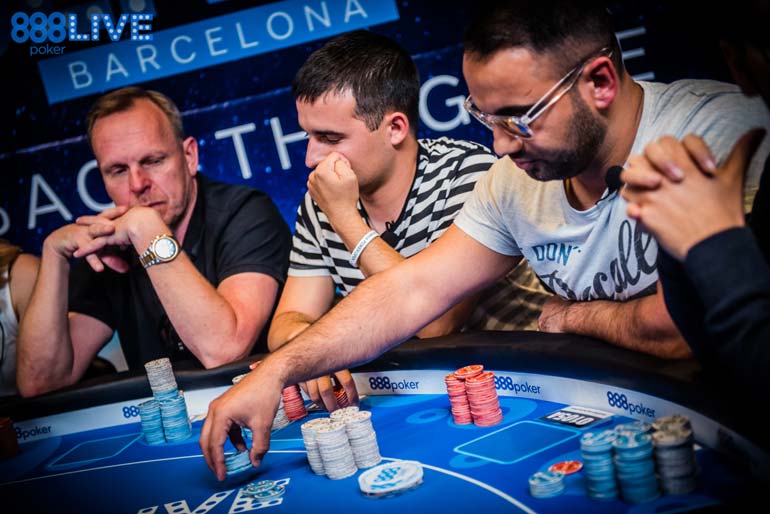“Short-handed poker” refers to any poker table with six players or less. Making the relevant adjustments when coming from a full-ring background is essential if we want to preserve our winrate.
Depending on the games, it can take time and focused effort to become a winner. Players often assume that if they don’t immediately make profits that it means there is something wrong. Nothing could be further from the truth.
Here are our top tips for playing short-handed poker and keeping that winrate on the up:
1. Loosen Up Starting Hand Requirements
The fewer the number of players at the table, the broader the range of hands we should play preflop. Of course, tight play is still the easiest way to make money in the majority of games – but it’s vital that our version of “tight” play is adjusted relative to the number of players at the table.
For example, a tight full-ring player will play around 15% of their starting hands while a tight short-handed 6-max player will often play above 20% of their starting hands. HU (heads up) poker (also considered a type of short-handed poker) will see tight players playing well above 50% of their starting hands.
2. Recognise Good Bluff Spots
Since we’ll have a broader range in general, it becomes less viable to play a strategy which is based solely around extracting value with made hands. We’ll need to identify decent bluff spots, or we’ll find ourselves getting run over. As a general rule, short-handed variants (such as 6-max and HU) attract stronger opposition than FR tables.
As an example of looking for excellent bluffing opportunities, any time our opponent skips a cbet opportunity (whether on the flop, turn or river), we’ll often find ourselves with a chance to make a profitable bluff.
Taking these opportunities when they arise will provide a significant boost to our winrate and make us a much tougher short-handed player in the long run.
3. Set Appropriate Bankroll Management
Put simply; short-handed poker is higher variance than full-ring poker. We should expect the money to go in more often and with closer equity. We need to make sure we have the type of bankroll that can withstand the swings.
Whatever bankroll management strategy we use for fullring games, we may want to tighten it when migrating to tables with fewer players. This scenario includes 6-max players looking to explore the world of heads-up poker.
Not only should we decide how many buy-ins we need to take a shot at the next limit up, but we should also consider when we should step down from our current limit if we suffer prolonged losses.

4. Invest in Mindset
Bigger swings mean bigger assaults on our mental state. A perfectly calm (full-ring) FR player could end up as a nervous wreck when trying 6-max or (heads-up) HU games for the first time.
We need to make sure we are up to the challenge by performing focused training on our mental state. There are books, articles and training videos that help poker players to avoid tilt and reach their A-game as frequently as possible.
It’s no secret that mindset can make or break an otherwise winning player. We could be the most talented poker player in the world, but if we are prone to tilt, we are not going to experience the success we deserve.
It just so happens that the smaller the number of players at the table, the more robust the mindset required to survive. We should be careful not to underestimate this when making the transition to tables with fewer players.
5. Set an Appropriate Number of Tables
This tip is really for those who like to play more than one table. Just because we might be able to play six FR tables does not mean that we can comfortably play six HU tables or even six 6-max tables.
Remember that we play a higher percentage of hands on each table when there are fewer opponents. So, with six FR tables, we will generally only be playing 1 or 2 hands at the same time. With six HU tables, we will always be playing six hands at once. That’s a huge difference.
Besides, any time we try a new variant of poker, we should be cutting down on the number of tables we play until we learn the ropes.
6. Profile Opponents Carefully
To “profile” an opponent in poker means to take careful note of his tendencies, arriving at an overall conclusion regarding the type of player.
- Is he a professional or a recreational player?
- In which spots does he call too much?
- Which spots does he fold too much in etc., etc.?
The reason this becomes especially important in shorthanded games is that we’ll find ourselves playing more hands against the same opponents. The extreme example is HU games, where we’ll play every single hand against the same opponent for an extended period. Having a good understanding of Villain’s leaks is going to be hugely profitable in such a scenario.
While such a discipline is still essential in FR, we may not play many pots against some of the opponents at our table. So, having a thorough analysis of Villain over on the far side of the table is not so helpful if we never find ourselves in a pot against him.
7. Thoroughly Plan and Put in Volume
This point really to any structured approach to taking money from the poker tables whether they are short-handed or not. One big leak many players have is that they put in volume “when they feel like it”. This situation is fine for amateur enthusiasts, but serious professionals need a clearly defined approach; otherwise, their volume will suffer.
It’s recommended to make use of an excel sheet or online calendar to carefully plan when we’ll put in our volume. Once we have created a schedule, we should do our best to stick to it. If we find it too rigorous, we can, of course, make changes, but the goal is to find a schedule that maximises our volume while avoiding burnout.
Once we generate the habit of playing specific amounts of volume on certain days, we’ll typically see that we are consistently playing more volume than previously. We’ll also avoid the trap of putting in extra volume to chase losses when stuck. (Chasing losses is detrimental for our mindset, can cause burnout, and causes us to put in extra volume when we are not playing our best.)
8. Study Off the Table Carefully
Any time we are transitioning to a new game type, it’s essential to hit the proverbial poker lab and see which adjustments need to be made to our existing strategy.
We should consider making use of one or all of the following -
- Poker software (i.e. equity calculators) in conjunction with HH reviews.
- DB analysis (using poker tracking software).
- Poker books.
- Training videos.
- Poker forums.
- Skype/Discord discussion groups.
The best players typically spend at least 20% of their poker time on studying (the remaining 80% on volume). When trying a new variant for the first time, the study/play ratio should often be closer to 50:50.
Of course, we don’t want to make the mistake of spending all of our time studying and not putting in decent volume at the tables (more common than we might think).
Without volume, we don’t make money.
9. Don’t Give Up!
Yup, it’s cheesy, but this is honestly how most poker players end up busting out of the shorthanded games. Not because they lost their bankroll, but because they couldn’t hack the learning curve.
They suffered initial losses (and mindset problems) and figured it was simply easier to quit than fight back.
It can easily take six months or longer to create a winning poker player. So, stick with it.
A man is not finished when he is defeated. He is finished when he quits.


